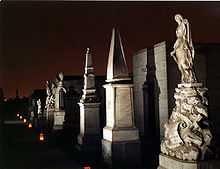Presbítero Maestro


Presbitero Maestro is a cemetery in Lima, the capital city of Peru. It is also a museum, though attempts to make it a museum exclusively have failed. The architectural styles of the mausoleums found within are broad ranging. It houses the remains of several important political, military and literary figures. Most prominent of all the mausoleums is the Panteón de los Próceres where heroes of the War of the Pacific (1879–1884) are buried. The mausoleum's entrance reads "La Nación a sus Defensores" (Meaning "The Nation, to its Defenders").
History
The cemetery wasn't finished until 1807, thanks to the efforts of the Priest Matías Maestro. This multifaceted man, born in Vitoria (Spain) in 1776, came to Peru by the end of the 18th century to start a new business. In 1793, he became a Catholic Priest and since then he dedicated himself to “renewing” the churches and altarpieces with the latest fashion style: Neoclassical. He became General Director of Lima’s Public Beneficence Society in 1826 and died on January 7, 1835.
